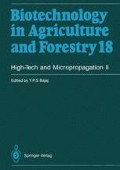Abstract
Pliny’s account of the beginning of the Christian era of wild raspberries that came from Mount Ida in Greece led Linnaeus to give the plant its botanical name Rubus idaeus. The first record of cultivated raspberries dates from around 1548 A.D. by Turner, an English herbalist. At this time the first raspberry plants were introduced into cultivation. These and other detailed accounts of raspberry history are given by Hedrick (1925).
Access this chapter
Tax calculation will be finalised at checkout
Purchases are for personal use only
Preview
Unable to display preview. Download preview PDF.
References
Anderson WC (1980) Mass propagation by tissue culture - principles and techniques. In: Proc Conf Nursery production of fruit plants through tissue culture - application and feasibility, Beltsville, Mar, pp. 1–10
Avitia Garcia E, Barrientos Perez F (1985) Cytokinins and red raspberry (Rubus idaeus L.) shoot proliferation in vitro. Hortic Mex 1 (1): 41–49
Baumann G (1982) Elimination of heat stable raspberry virus by combining heat treatment and meristem culture. Acta Hortic 129: 11–13
Baumann G, Hoffmann K (1986) The influence of heat-labile viruses of raspberry common mosaic on growth and cropping of red raspberry. Acta Hortic 186: 39–46
Baumann G, Theiler-Hedtrich R, Casper R (1988) Detection of sap-transmissible viruses by ELISA in tissue-propagation of red raspberry during in vitro culture. J Phytopathol 122: 372–375
Converse RH (1963) Influence of heat-labile components of the raspberry mosaic virus complex on growth and yield of red raspberries. Phytopathology 53: 1251–1254
Converse RH (1966) Effect of heat treatment of the raspberry mosaic virus complex in Latham red raspberry. Phytopathology 56: 556–559
Converse RH (1970) Virus and virus like diseases of raspberry and blackberry. In: Frazier NW (ed) Virus diseases of small fruits and grapevine, sect 3. Univ Cal Press, Berkeley, pp 107–110
Converse RH (1979) Recommended virus-indexing procedures for new USDA small fruit and grape cultivars. Plant Disease Rep 63: 848–851
Converse RH (1987) Virus diseases of small fruits. Agricultural handbook 631. Corvallis, Or
Desjardines Y, Gosselin A (1987) The effect of hormonal concentration, culture medium and an antioxidant on the shoot-doubling time for the raspberry cultivar Madawaska grown in vitro. Can J Plant Sci 67 (3): 763–69
FAO (ed) (1987) Production yearbook, vol 40. FAO Rome
Freeman JA, Stace-Smith R (1970) Effect of raspberry mosaic virus on yield and growth of red raspberries. Can J Plant Sci 50: 521–527
Hedrick UP (1925) The small fruits of New York. Report of the New York State Agricultural Experiment Station. Lyon Comp Printers, Albany
Hoffmann K, Baumann G (1983) Wachstum und Ertrag virusfreier Himbeerpflanzen. Obstbau 8 (7): 318–320
Huth W (1979) Kultur von Himbeerpflanzen aus apikalen Meristemen. Gartenbauwissenschaft 44: 53–55
James DJ (1979) The role of auxin and phloroglucinol in adventitious root formation in Rubus and Fragaria grown in vitro. J Hortic Sci 54 (4): 273–277
James DJ, Knight VH, Thurbon IJ (1980) Micropropagation of red raspberry and the influence of phloroglucinol. Sci Hortic 12: 313–319
Jennings DL (1979) Plant breeding. Annu Rep Scot Hortic Inst 25: 54–70
Jones AT (1979) Some effect of latent virus infection in red raspberry. Acta Hortic 95: 63–70
Klokonos NP, Soloveva II (1987) Propagation of raspberry by the tissue culture method. Ref Zh 1, 55: 623
Murashige T, Skoog F (1962) A revised medium for rapid growth and bioassays with tobacco tissue cultures. Physiol Plant 15: 473–497
Putz C (1971) Obtention de framboisiers (var. Bois Blanc) sans virus par la technique des cultures de meristemes. Ann Phytopath 3 (4): 493–501
Pyott YK, Converse RH (1981) In vitro propagation of heat treated red raspberry clones. Hortscience 16 (3): 308–309
Ourecky DK (1975) Brambles. In: Janick J, Moore JN (eds) Advances in fruit breeding, Purdue Univ Press, West Lafayette Indiana, pp 98–116
Quak F (1977) Meristem culture and virus-free plants. Applied and fundamental aspects of plant cell, tissue, and organ culture. In: Reinert J, Bajaj YPS (eds) Springer, Heidelberg, New York, Berlin, pp 598–615
Rover A, Hedtrich CM, Feucht W (1979) In-vitro-Kulturen von Himbeer-Triebspitzen unter dem Aspekt der Virusfreiheit. Erwerbsobstbau 2, 28–30
Shchelkunova SE (1974) Seasonal periodicity of plant regeneration from meristem tips of raspberry. Fiziol Rast (Sov Plant Physiol) 21: 54–58
Shchelkunova SE, Popov Yu.G. (1970) Poluchenie svobodnykh ot virusa rasteny maliny putem kultury izolirovanykh apeksov Fiziol Rast (Sov Plant Physiol.) 17: 618–622
Snir I (1988) Red raspberry (Rubus idaeus). In: Bajaj YPS (ed) Biotechnology in agriculture and forestry, vol 6: Crops II. Springer, Berlin Heidelberg New York, pp 124–141
Sobczykiewicz D (1980) Preliminary note on mass production of raspberry plants through placing unrooted plantlets obtained from meristem cultures directly in the soil. Fruit Sci Rep 7 (1): 1–3
Sobczykiewicz D (1982) Mikrorozmnazanie roslin jagodowych (Micropropagation of small fruits). Ogrodnictwo 7: 176–178
Sobczykiewicz D (1983) Meristem culture for the production of virus-free raspberry plants. Zesz Probl Post Nauk Rolnicz 291: 299–303
Sobczykiewicz D (1984) Mass production of raspberry plantlets through micropropagation and rooting them directly in sand-peat mixture. Fruit Sci Rep 11 (2): 73–77
Sobczykiewicz D (1986) Elimination of heat-stable raspberry vein chlorosis virus by meristem culture. Acta Hortic 186: 47–49
Sobczykiewicz D (1987) Mass production of raspberry plants by meristem culture. Acta Hortic 212: 607–609
Vertesy J (1979) Experiments on the production of virus-free raspberry propagation material by meristem culture. Acta Hortic 95: 77–79
Author information
Authors and Affiliations
Editor information
Editors and Affiliations
Rights and permissions
Copyright information
© 1992 Springer-Verlag Berlin Heidelberg
About this chapter
Cite this chapter
Sobczykiewicz, D. (1992). Micropropagation of Raspberry (Rubus idaeus L.). In: Bajaj, Y.P.S. (eds) High-Tech and Micropropagation II. Biotechnology in Agriculture and Forestry, vol 18. Springer, Berlin, Heidelberg. https://doi.org/10.1007/978-3-642-76422-6_18
Download citation
DOI: https://doi.org/10.1007/978-3-642-76422-6_18
Publisher Name: Springer, Berlin, Heidelberg
Print ISBN: 978-3-642-76424-0
Online ISBN: 978-3-642-76422-6
eBook Packages: Springer Book Archive

